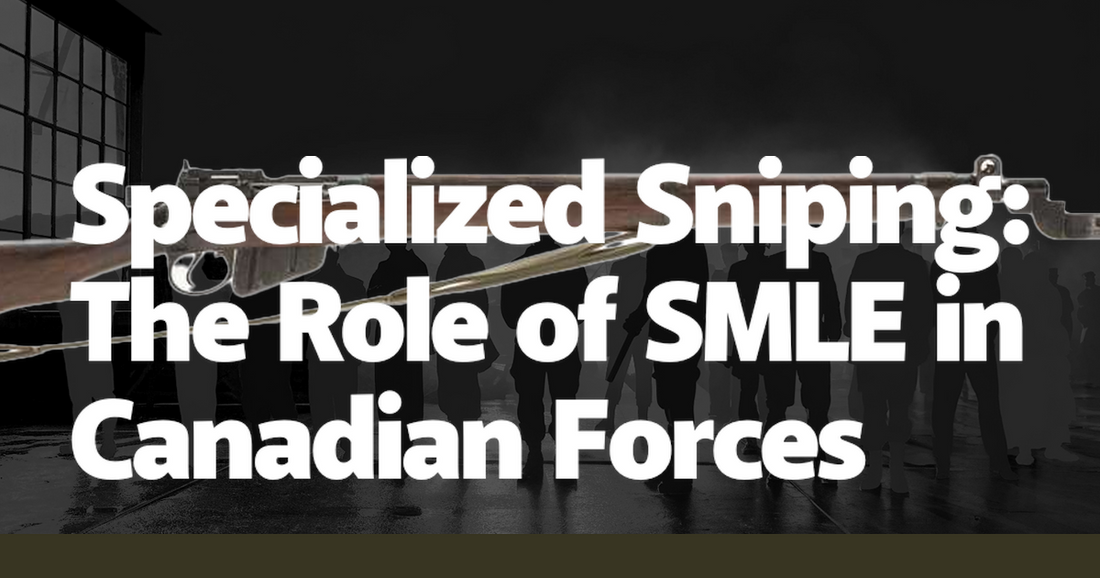The Short Magazine Lee-Enfield (SMLE) rifle holds a storied place in the annals of military history, particularly within the Canadian Forces. This bolt-action rifle, introduced at the turn of the 20th century, became a symbol of precision and reliability. The SMLE was not just a weapon; it was an instrument of specialized sniping that saw Canadian soldiers through some of the most grueling conflicts of the 20th century. Its role in the trenches of World War I and the rugged terrains of World War II is etched into the legacy of Canadian military prowess.
In the First World War, the SMLE's short length and rapid rate of fire—thanks to its ten-round magazine—made it a formidable tool for Canadian snipers. The rifle's design allowed for quick, successive shots, a critical advantage in the trench warfare that defined much of the Great War. Canadian snipers, often operating in the most perilous conditions, relied on the SMLE's dependability. Anecdotes from the Battle of Vimy Ridge in 1917 illustrate the rifle's impact. Canadian snipers, using the SMLE, were able to suppress enemy machine-gun nests, providing crucial support for advancing infantry. The success of these snipers was a testament to their skill and the reliability of their rifles.
World War II saw the SMLE continue its service, albeit with some modifications to suit the evolving demands of warfare. The No. 4 Mk I variant, with its improved accuracy and simplified construction, became the standard issue. Canadian snipers, often operating in the dense forests of Europe or the harsh conditions of the Italian Campaign, found the SMLE to be an invaluable asset. The rifle's robustness and accuracy were critical in these varied environments. Stories from the Battle of Ortona, where Canadian forces faced fierce resistance, highlight the SMLE's role. Snipers were able to pick off enemy soldiers with precision, often turning the tide in critical skirmishes.
The SMLE's role in specialized sniping was not just about the rifle itself, but also about the training and doctrine that Canadian snipers underwent. Sniping schools, such as the one established at the Canadian Corps School of Sniping in 1916, emphasized marksmanship, camouflage, and fieldcraft. These schools produced some of the most skilled snipers of the era. The combination of rigorous training and the reliable SMLE created a formidable force on the battlefield. The sniper's role was to observe, report, and eliminate high-value targets, tasks that required patience, precision, and the utmost trust in their equipment.
Post-World War II, the legacy of the SMLE continued to influence Canadian sniping tactics and training. Even as newer rifles were introduced, the principles learned with the SMLE remained foundational. The rifle's impact was such that it became a part of the Canadian military's identity. Veterans would recount their experiences with the SMLE, often highlighting how the rifle had saved their lives or turned the tide in a battle. These stories became a part of the collective memory of the Canadian Forces, underscoring the rifle's importance.
In more recent conflicts, the principles of specialized sniping honed with the SMLE have continued to evolve. Modern Canadian snipers, equipped with state-of-the-art rifles and technology, still draw on the lessons learned from their predecessors. The emphasis on marksmanship, patience, and the ability to adapt to any environment are legacies of the SMLE era. The rifle may no longer be in active service, but its influence is undeniable. The SMLE's role in shaping Canadian sniping doctrine is a testament to its enduring legacy.
The cultural impact of the SMLE extends beyond the battlefield. In Canadian military museums and collections, the rifle is often a centerpiece, symbolizing a significant era in the nation's military history. Collectors and historians alike hold the SMLE in high regard, not just for its technical specifications but for the stories and sacrifices it represents. The rifle has become a symbol of Canadian resilience and ingenuity, a reminder of the challenges faced and overcome by soldiers in the past.
In conclusion, the SMLE's role in specialized sniping within the Canadian Forces is a rich tapestry of history, skill, and innovation. From the trenches of World War I to the diverse theaters of World War II, the SMLE proved to be more than just a rifle. It was a trusted companion for Canadian snipers, a tool that helped shape military tactics and training. Its legacy continues to influence modern sniping practices, a testament to its enduring impact. The stories of the SMLE and the snipers who wielded it are a vital part of Canadian military heritage, reflecting a tradition of excellence and dedication that persists to this day.

